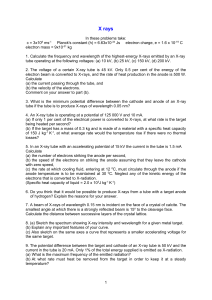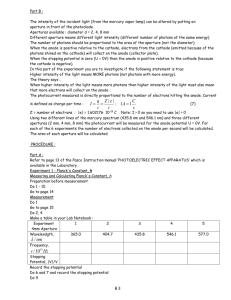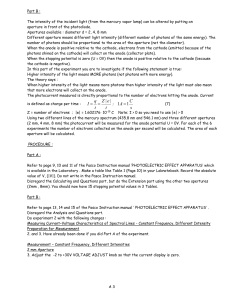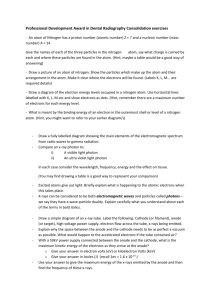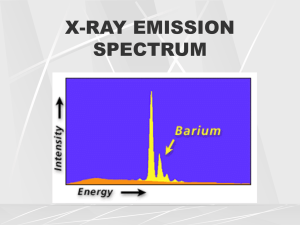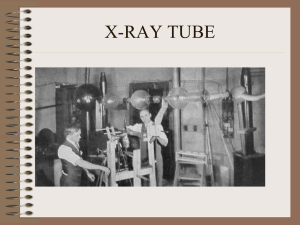The primary components of an x-ray machine are the x
advertisement
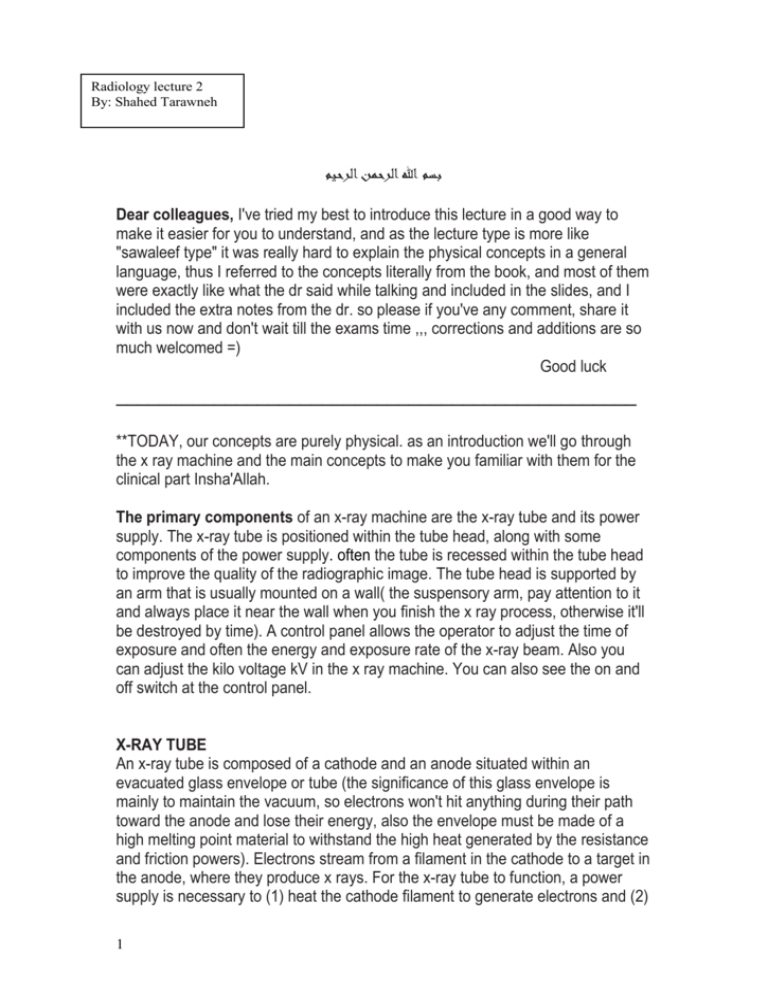
Radiology lecture 2 By: Shahed Tarawneh بسم هللا الرحمن الرحيم Dear colleagues, I've tried my best to introduce this lecture in a good way to make it easier for you to understand, and as the lecture type is more like "sawaleef type" it was really hard to explain the physical concepts in a general language, thus I referred to the concepts literally from the book, and most of them were exactly like what the dr said while talking and included in the slides, and I included the extra notes from the dr. so please if you've any comment, share it with us now and don't wait till the exams time ,,, corrections and additions are so much welcomed =) Good luck ــــــــــــــــــــــــــــــــــــــــــــــــ **TODAY, our concepts are purely physical. as an introduction we'll go through the x ray machine and the main concepts to make you familiar with them for the clinical part Insha'Allah. The primary components of an x-ray machine are the x-ray tube and its power supply. The x-ray tube is positioned within the tube head, along with some components of the power supply. often the tube is recessed within the tube head to improve the quality of the radiographic image. The tube head is supported by an arm that is usually mounted on a wall( the suspensory arm, pay attention to it and always place it near the wall when you finish the x ray process, otherwise it'll be destroyed by time). A control panel allows the operator to adjust the time of exposure and often the energy and exposure rate of the x-ray beam. Also you can adjust the kilo voltage kV in the x ray machine. You can also see the on and off switch at the control panel. X-RAY TUBE An x-ray tube is composed of a cathode and an anode situated within an evacuated glass envelope or tube (the significance of this glass envelope is mainly to maintain the vacuum, so electrons won't hit anything during their path toward the anode and lose their energy, also the envelope must be made of a high melting point material to withstand the high heat generated by the resistance and friction powers). Electrons stream from a filament in the cathode to a target in the anode, where they produce x rays. For the x-ray tube to function, a power supply is necessary to (1) heat the cathode filament to generate electrons and (2) 1 establish a high-voltage potential between the anode and cathode to accelerate the electrons toward the anode. Cathode The cathode in an x-ray tube consists of a filament and a focusing cup. The filament is the source of electrons within the x-ray tube. It is a coil of tungsten wire. The filament is heated to incandescence( ) توهج حراريby the flow of Current from the low-voltage source and emits electrons at a rate proportional to the temperature of the filament. The filament lies in a focusing cup, a negatively charged concave reflector. the parabolic shape of the focusing cup electrostatically focuses the electrons emitted by the filament into a narrow beam directed at a small rectangular area on the anode called the focal spot. The electrons move in this direction because they are both repelled by the negatively charged cathode (filaments in the focusing cup) and attracted to the positively charged anode. The x-ray tube is evacuated to prevent collision of the fastmoving electrons with gas molecules, which would significantly reduce their speed. The vacuum also prevents oxidation, “burnout,” of the filament. Now, we've something called the thermionic emission. What do we mean by this?? As we said before, the main functioning unit in the cathode is the filament. Filaments should have high electrical conductivity and high vapor pressure (in the book they say low vapor pressure, so I'm not sure about this, I put both info, so chose what you trust more ),,now how electrons come out ?? Actually electrons are pulled off the tungsten filaments which have high mill amperage current. high mill amperage current means high number of electrons which will lead to high resistance and friction ending as heat, heat will make electrons at the outer shell to move toward the surface (at the surface of the filament), now the difference in the kilo voltage between the cathode and the anode will make those electrons to move toward the anode. This is how literally the dr explained the thermionic emission. Anode The anode consists of a tungsten target embedded in a copper stem. The purpose of the target in an x-ray tube is to convert the kinetic energy of the colliding electrons into x-ray photons. The target is made of tungsten, an element that has several characteristics of an ideal target material. It has a high atomic number , a high melting point, high thermal conductivity, and low vapor pressure at the working temperatures of an x-ray tube. 2 A target made of a high atomic number material is most efficient in producing x rays. Because heat is generated at the anode, the requirement for a target with a high melting point is clear. Tungsten also has high thermal conductivity, thus readily dissipating its heat into the copper stem. Finally, the low vapor pressure of tungsten at high temperatures helps maintain the vacuum in the tube at high operating temperatures. Production of x ray: Most high-speed electrons traveling from the filament to the target interact with target electrons and release their energy as heat. Occasionally, however, electrons convert their kinetic energy into x-ray photons by the formation of bremsstrahlung and characteristic radiation. BREMSSTRAHLUNG RADIATION (breaking radiation) The sudden stopping or slowing of high-speed electrons by tungsten nuclei in the target produces bremsstrahlung photons, the primary source of radiation from an x-ray tube. Electrons from the filament directly hit the nucleus of a target atom. When this happens, all the kinetic energy of the electron is transformed into a single x-ray photon. CHARACTERISTIC RADIATION Characteristic radiation contributes only a small fraction of the photons in an x-ray beam. It occurs when an incident electron ejects an inner electron from the tungsten target. When this happens, an electron from an outer orbital is quickly attracted to the void in the deficient inner orbital. When the outer-orbital electron replaces the displaced electron, a photon is emitted with an energy equivalent to the difference in the two orbital binding energies. Line focus principle (dissipation of heat): The focal spot is the area on the target to which the focusing cup directs the electrons and from which x rays are produced. The heat generated per unit target area, however, becomes greater as the focal spot decreases in size. To take advantage of a small focal spot while distributing the electrons over a larger area of the target, the target is placed at an angle to the electron beam (when the area is larger, more heat will dissipate). The apparent size of the focal spot seen from a position perpendicular to the electron beam (the effective focal spot) is smaller than the actual focal spot size. 3 why I put the target at an angle and not simply make the focal spot area larger?? Because if you make this area larger, you'll affect the picture resolution and make it bad, thus we don't play with it directly. Another method of dissipating the heat from a small focal spot is to use a rotating anode; In this case the tungsten target is in the form of a beveled disk that rotates when the tube is in operation. As a result, the electrons strike successive areas of the target, widening the focal spot by an amount corresponding to the circumference of the beveled disk, thus distributing the heat over this extended area. now, what's my aim of dissipating the heat?? I don't want the heat because it'll make the x ray machine with shorter life and you'll need to give time between each patient till the machine temperature goes back to normal, which is not practical when you are dealing with lot of patients, also you can't prolong the exposure time intraoral for the patients when the machine temperature is high. (please refer to figure 1-9, 1-10 page 7 in the book, It didn't work with me to paste them here, and they can be useful for understanding). POWER SUPPLY The primary functions of the power supply of an x-ray machine are to (1) provide a low-voltage current to heat the x-ray tube filament and (2) generate a high potential difference between the anode and cathode (high mill amper). **milli amperage: the number of electrons going through a piece of material in seconds. **kilo voltage is about energy. Why I care about these two concepts?? Because many errors while taking the x ray picture are related to the milli amper (mA) and kilo voltage peak (kvp) which were taken during the operation. How can we achieve low voltage and high milli amper?? by simply using a transformer. You should note that we can never use the AC current in the x ray machine, we need the DC current!! Why?? Because the AC current will move the electrons from the anode to the cathode, and as we said previously, to generate the x ray we need the electrons to move from the cathode to the anode while the other way around is going to be only a waste of time for you and your patient as well for the effectiveness of the x ray machine. 4 The x ray machines have the ability to transform the AC into DC, in a process called: rectification. The rectification will increase the energy and decrease the exposure time. X rays are produced at the target with greatest efficiency when the voltage applied across the tube is high (the dr said when the voltage is medium). (the dr showed some graphs, I searched for them but couldn't find them in the book, so if anyone has the information related to those graphs please provide us with them.) Why I prefer the constant x ray generation?? 1). High efficiency 2).high mean energy of the beam. 3).shorter exposure time. TIMER A timer is built into the high-voltage circuit to control the duration of the x-ray exposure. We always have to relate the timer to its "twin" which is the milli amper. (MAS: milli amper per second). When we are talking about the exposure time and the image quality we care about: kvp and Ma per second (MAS). Factors controlling the x ray beam: 1) EXPOSURE TIME Changing the time controls the duration of the exposure and thus the number of photons generated. When the exposure time is doubled, the number of photons generated at all energies in the x-ray emission spectrum is doubled, but the range of photon energies is unchanged. Note: ** dark picture means over exposure and high number of photons and high mA. ** White picture means the opposite. 5 **(not related concept the dr talked about it here is the contrast( التفاضلية بين )األنسجةof the x ray picture; which can be identified through using the difference between the enamel and dentine, the enamel appears clearly white while the dentine is grey,when these colors are not well separated it's either because of a disease or related to a contrast issue. when you increase the energy, you effect the contrast >> بمعنى أنا لما أعطي طاقة قوية راح تأكل األخضر واليابس يعني راح اتروح فمثال ليش االينامل بتظهر,التفاضلية بين األنسجة اللي إحنا منستعملها عشان نفرق بين األنسجة باللون األبيض؟؟ ببساطة ألنها بتمنع طاقة الفوتونات من اختراقها بينما يظهر الدينتين باللون هالطاقة، لكن أنا لما من البداية أعطي طاقة عالية جدا,الرمادي ألن الفوتونات تستطيع اختراقه راح يكون عندها القدرة الختراق جميع األنسجة و هون راح يروح عنا الcontrast. Thus never ever try to play with the kilo voltage, only you can change the MAS. 2) TUBE CURRENT (mA) The quantity of radiation produced by an x-ray tube (i.e., the number of photons that reach the patient and film) is directly proportional to the tube current (mA) and the time the tube is operated. The dr showed us graphs that show: 1). Spectrum of photon energies showing that as tube current(mA) increases (kVp and exposure time held constant), so does the total number of photons. 2). Spectrum of photon energies showing that, as exposure time increases (kVp and tube voltage held constant), so does the total number of photons. 3). Spectrum of photon energies showing that, as the kVp is increased (tube current and exposure time held constant), there is a corresponding increase in the mean energy of the beam, the total number of photons emitted, and the maximal energy of the photons. 3) TUBE VOLTAGE (kVp) Increasing the kVp increases the potential difference between the cathode and the anode, thus increasing the energy of each electron when it strikes the target. This results in an increased efficiency of conversion of electron energy into x-ray photons and thus an increase in (1) the number of photons generated, (2) their mean energy, and (3) their maximal energy. 6 4) FILTRATION Although an x-ray beam consists of a spectrum of x-ray photons of different energies, only photons with sufficient energy to penetrate through anatomic structures and reach the image receptor. Photons that are of such low energy that they cannot reach the receptor contribute to patient exposure (risk) but do not offer any benefit. Consequently, to reduce patient dose, such low-energy photons should be removed from the beam. This can be accomplished, in part, by placing an aluminum filter in the path of the beam. An aluminum filter preferentially removes many of the lower-energy photons with lesser effect on the higher-energy photons that are able to contribute to making an image. Inherent filtration consists of the materials that x-ray photons encounter as they travel from the focal spot on the target to form the usable beam outside the tube enclosure. These materials include the glass wall of the x-ray tube, the insulating oil that surrounds many dental tubes, and the barrier material that prevents the oil from escaping through the x-ray port. Filtration increases the peak energy. راح يعال المعدل,أنا لما اشيلهم وارجع احسب المعدل للشعبة, راسبين10 زي لما يكون عنا 5) COLLIMATION or beam restriction فكرة انك ال تعرض مريضك ألكثر مما يحتاج A collimator is a metallic barrier with an aperture in the middle used to reduce the size of the x-ray beam and thereby the volume of irradiated tissue. Round and rectangular collimators are most frequently used in dentistry. A round collimator is a thick plate of radiopaque material (usually lead) with a circular opening centered over the port in the x-ray head through which the x-ray beam emerges. Typically, round collimators are built into open-ended aiming cylinders. Rectangular collimators further limit the size of the beam to just larger than the xray film, thereby further reducing patient exposure. Some types of film-holding instruments also provide rectangular collimation of the x-ray beam !! يعني أنا بدي أخد صورة لسن مريضي ليش اروح اخد صورة لبطنه كمان Use of collimation also improves image quality. When an x-ray beam is directed at a patient, the hard and soft tissues absorb about 90% of the photons and about 10% pass through the patient and reach the film. Many of the absorbed photons generate scattered radiation within the exposed tissues by a process called Compton scattering. These scattered photons travel in all directions, and some reach the film and degrade image quality. Collimating the x-ray beam thus reduces the exposure area and thus the number of scattered photons reaching the film. (scatter kills your contrast; the more scatter, the less contrast). 7 6) the distance (will be discussed later.) 7) The target material. ــــــــــــــــــــــــــــــــــــــــــــــــ 8
